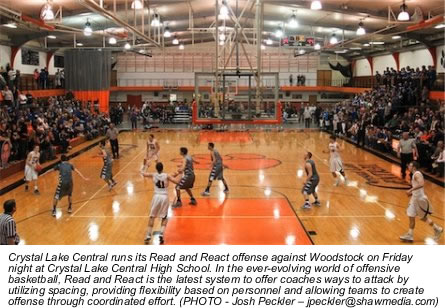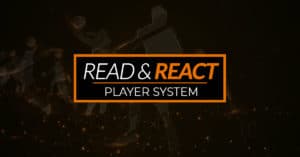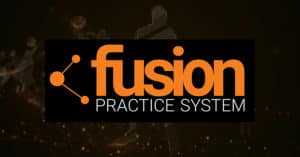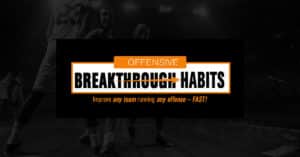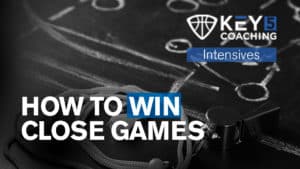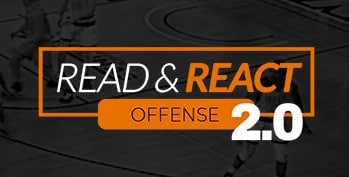Written By JOE STEVENSON (as appeared in the Northwest Herald on Sunday, January 13th, 2013)
Every year, Rich Czeslawski heads to the NCAA Final Four to watch basketball, network and, perhaps most importantly, learn.
Czeslawski had just finished his first season as Crystal Lake Central’s boys basketball coach in 2007 when he headed to Atlanta for the Final Four. While there, he attended a coaching clinic and caught a glimpse of the future.
The clinician, Rick Torbett, is considered one of the foremost basketball teaching authorities in the world and distributes teaching videos on betterbasketball.com, many of which involve his Read and React offense. At that clinic, Czeslawski saw the future of his program with Read and React, an offense that can be taught in layers, offers flexibility against man or zone defenses and can be difficult to scout.
In the ever-evolving world of offensive basketball, Read and React is the latest system to offer coaches ways to attack by utilizing spacing, providing flexibility based on personnel and allowing teams to create offense through coordinated effort. Dribble-Drive Motion, motion and Princeton are other popular ways that use some similar concepts.
“We went to Read and React three years ago. It’s a very intelligent way of teaching a free-flowing offense,” Czeslawski said. “(Cary-Grove girls coach) Rod Saffert is running it. (Prairie Ridge boys coach) Corky (Card) is running it. I don’t really feel it’s a fad offense; it’s a way of teaching offense. You’re teaching offense and empowering players.”
While Czeslawski has had good talent with which to work in those three seasons, he thinks Read and React has helped the Tigers go 60-12 over that stretch.
When Czeslawski invited Torbett to Crystal Lake last summer, there were 40 coaches who attended a roundtable discussion to learn more about Read and React. Johnsburg boys coach Mike Toussaint was one of them, and while he had not fully implemented it with his varsity, the Skyhawks’ feeder program and lower levels are running it.
“I would say there is more freedom now with offenses,” said Toussaint, a 1986 Johnsburg graduate. “When I was playing, it was pass and screen away and everything was pretty structured. Players are more athletic now and there’s more freedom for players. Pass and cut, pass and cut. Everything is going toward the basket. It’s hard to scout because there’s no pattern to it. It used to be you could watch a team and see them do something and know what to expect.”
More offenses may look to screen for players with the ball, but don’t screen away from the ball as much as they used to. Huntley coach Marty Manning, who uses some motion offense principles combined with other offenses, says there usually is a trickle-down effect with trends like this.
“Ten or 15 years ago when the NBA started really calling handchecking, it opened up for guards to dribble and drive,” Manning said. “That filtered down to colleges and then high school kids saw that. And kids practice 3-point shots a lot more, so offenses are tailored around that. On AAU teams, they’re using a lot of dribble-drive.
“Kids today rarely like to sit inside and work on their post moves, they want to shoot 3s and work on ball handling. That’s kind of the way the game has evolved.”
Also, defenses have gotten better. And more physical. Czeslawski and Manning both say players don’t enjoy posting up as much because of the physical play inside.
“Along the block you’re going to get elbowed and pushed around,” Manning said. “It’s natural that kids don’t want to do that. That’s a negative for offenses because it’s harder to make a 19-footer than a 2-footer. That’s probably why you see lower shooting percentages.”
Jacobs coach Jim Hinkle runs a more structured flex offense, but also uses some motion offense with the Golden Eagles. But he prefers his offense to be unstructured.
“A perfect night is if we don’t have to set up, we just get the ball up the floor and run,” Hinkle said. “Half-court is our secondary game, but the half-court has become the primary game for most teams. Take your time, throw your 10 passes. I’m still like (legendary Ohio State football coach) Woody Hayes, who said, ‘When you pass, three things can happen and two of them are bad.’ When you shoot, two things can happen and only one is bad.”
Czeslawski likes the unpredictability that Read and React offers, along with the way it can be taught and added to as players progress. He has taught a couple layers in his feeder system, then they add more as players move up.
“Spacing is still the most important thing with offense,” Czeslawski said. “We’re teaching spacing and empowering players. What the guy with the ball does, people react to. There are aspects of other offenses with it. We were at a camp and three coaches saw snippets of what we were doing. One asked if we were running dribble-drive, one thought it was Princeton and one thought it was the triangle.”

